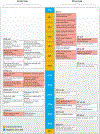Why Lungs Keep Time: Circadian Rhythms and Lung Immunity
- PMID: 31561746
- PMCID: PMC8818323
- DOI: 10.1146/annurev-physiol-021119-034602
Why Lungs Keep Time: Circadian Rhythms and Lung Immunity
Abstract
Circadian rhythms are daily cycles in biological function that are ubiquitous in nature. Understood as a means for organisms to anticipate daily environmental changes, circadian rhythms are also important for orchestrating complex biological processes such as immunity. Nowhere is this more evident than in the respiratory system, where circadian rhythms in inflammatory lung disease have been appreciated since ancient times. In this focused review we examine how emerging research on circadian rhythms is being applied to the study of fundamental lung biology and respiratory disease. We begin with a general introduction to circadian rhythms and the molecular circadian clock that underpins them. We then focus on emerging data tying circadian clock function to immunologic activities within the respiratory system. We conclude by considering outstanding questions about biological timing in the lung and how a better command of chronobiology could inform our understanding of complex lung diseases.
Keywords: circadian; clock; inflammation; lung; pulmonary; rhythm.
Figures




References
-
- Karamanou M, Androutsos G. 2011. Aretaeus of Cappadocia and the first clinical description of asthma. Am. J. Respir. Crit. Care Med 184:1420–21 - PubMed
-
- Aretaeus. 1861. The Extant Works of Aretaeus, the Cappadocian, transl. F Adams, London: Sydenham Soc.
-
- Natl. Asthma Educ. Prev. Prog 2007. Guidelines for the diagnosis and management of asthma. Expert Panel Rep. 3, US Dep. Health Hum. Serv., Washington, DC. https://www.nhlbi.nih.gov/files/docs/guidelines/asthsumm.pdf
-
- Martin RJ. 1992. Circadian rhythms, nocturnal asthma, and management. Ann. Allergy 69:267–72 - PubMed
-
- Smolensky MH, Barnes PJ, Reinberg A, McGovern JP. 1986. Chronobiology and asthma. I. Day-night differences in bronchial patency and dyspnea and circadian rhythm dependencies. J. Asthma 23:321–43 - PubMed
Publication types
MeSH terms
Grants and funding
LinkOut - more resources
Full Text Sources

